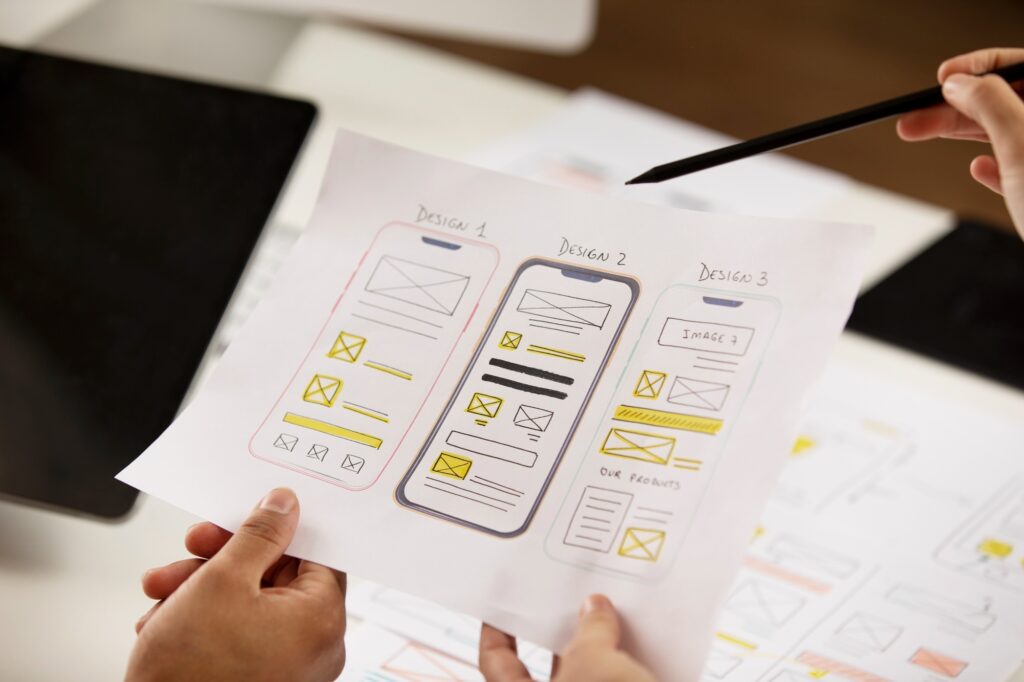By now, you probably heard the phrase “digital presence”. In this post we will discuss how to increase your digital presence through good website design.
Which brings me to the next question: how do we even start judging what is a “good” design?
Welcome to the enchanting world of website design, where the fusion of art and technology comes together to create your digital masterpiece.
The new rules of first impressions
In an era where first impressions are made on screens rather than in person, your website stands as the virtual face of your business. It’s not just about aesthetics; it’s about the science of captivating your audience and conveying your message effectively. Website design can truly transform your online presence.https://shocomarketing.com/wp-content/uploads/2023/10/The-Beauty-of-Website-Design-scaled.jpg
94% of first impressions are design-related?
Your website’s design is the gateway to establishing trust and credibility, setting the stage for your visitors’ journey through your online world.
38% of people will stop engaging with a website if the content or layout is unattractive.
Your website’s design is not just about looking good; it’s about keeping your audience engaged, enticing them to explore further, and ultimately converting them into loyal customers.
Steve Jobs wisely said, “Design is not just what it looks like and feels like. Design is how it works“.
This quote emphasizes that great design goes beyond the visual and delves into the functionality, creating a seamless user experience.
Your website is your “canvas”, your opportunity to leave a mark on your visitors in the digital landscape.
How can you send a message using good design?
When a potential customer lands on your website, their initial perception is largely influenced by its design. A well-crafted website is more than a visual treat; it’s your ultimate sales pitch.
Truth be told, I don’t really like the design of the global e-commerce giant, Amazon… However, their website is a good example of the power of design. Regardless of personal taste, the placement of product images, user-friendly navigation, and the one-click shopping feature have all contributed to Amazon’s tremendous success. It’s not just their extensive product catalog; it’s the well-thought-out design that keeps customers coming back.
The benefits to small and medium businesses
It’s not just industry giants benefiting from impeccable web design. Consider a small local business: by revamping their outdated website and making it visually appealing with high-quality images, they witness a substantial increase in online reach.
We have seen this time and time again with websites we designed: where the new design transformed the business’ presence and success potential.
Storytelling through Web Design
The art of storytelling is more than just words on a screen; it’s about creating a narrative that resonates with your audience, stirs emotions, and compels them to take action.
Consider the following elements:
1. Great Content:
Your website is your digital storybook, and your content is the plot. The narrative of your brand, your journey, your mission, and your values should be woven into every page.
Engage your audience with authentic, relatable stories. Take inspiration from renowned brands like Nike, whose website tells the story of athletes and their triumphs, forging a powerful connection with customers.
2. Visual Storytelling:
A picture is worth a thousand words, and in web design, visuals play a pivotal role. Make it a point to use high-quality images and videos to convey your message.
Imagine a boutique hotel website that showcases its serene location, luxurious rooms, and fine dining through captivating visuals, inviting visitors to experience their story in person.
3. Case Studies and Testimonials:
Real-life success stories are compelling narratives. Share how your product or service has positively impacted your customers through case studies and testimonials.
Airbnb’s website, for example, tells the stories of hosts and travelers, creating a sense of community and trust.
4. User Experience and Story Flow:
The structure of your website should guide visitors through your narrative seamlessly. The homepage is the opening chapter, introducing your brand, and subsequent pages develop the plot.
For example, an e-learning platform’s website may start with a story about a student’s journey to success and lead visitors to explore courses that can help them achieve similar results.
In essence, storytelling in web design humanizes your brand, evokes emotions, and fosters trust. Your website becomes a portal to an immersive and engaging narrative, inviting visitors to become active participants in your story.
By integrating storytelling into your web design, you can differentiate your business from the competition and create a lasting impact.
Remember, your website is not just about displaying information; it’s about inviting visitors to become a part of your story.
Types of Design in Contemporary Website Design
In the creative field of website design, designers draw inspiration from various styles to create engaging and visually appealing websites. Each design style has its unique characteristics, benefits, and shortcomings.
Here are five prominent types of design in modern web development:
1. Minimalist Design
Benefits:
Minimalism emphasizes simplicity and clean lines. It often employs ample white space, limited color palettes, and straightforward typography. This style focuses on delivering a clutter-free, user-friendly experience. Minimalist websites usually load quickly and are easy to navigate.
Shortcomings:
While minimalist design can be visually striking, it may not suit every brand or content type. The challenge lies in finding the right balance between simplicity and conveying essential information effectively. Overly minimalistic designs risk appearing bland or lacking in personality.
2. Material Design
Benefits:
Material design, popularized by Google, focuses on depth, shadow, and responsive animations. It provides a modern and interactive user experience, making websites feel dynamic and engaging. Material design’s visual language is consistent, which aids in user comprehension.
Shortcomings:
Implementing material design can be complex and resource intensive. Overuse of animations and shadows can lead to slow page loading times. Moreover, achieving a unique brand identity within the constraints of material design can be challenging.
3. Retro and Vintage Design
Benefits:
Nostalgia is a powerful emotion. Retro and vintage design styles leverage this sentiment to create a sense of familiarity and trust. This approach can help brands stand out by embracing a unique aesthetic.
Shortcomings:
The risk with retro design is appearing outdated rather than nostalgic. Balancing modern functionality with vintage aesthetics can be challenging. Furthermore, not all audiences resonate with retro design, which may limit its appeal.
4. Illustrative Design
Benefits:
Illustrative design is all about custom illustrations, icons, and graphics to convey information. It adds a creative and distinctive touch to websites, making them memorable and engaging. Illustrations can simplify complex concepts and create a strong brand identity.
Shortcomings:
Creating high-quality illustrations can be time-consuming and may require a skilled illustrator. Overly intricate illustrations can clutter a website and impact load times. It’s essential to ensure the illustrations align with the overall message and brand.
5. Responsive Parallax Design
Benefits:
Parallax design creates an immersive and interactive experience by moving elements at different speeds as users scroll. It adds depth to web pages, making content more engaging. Responsive parallax design adapts to various screen sizes, enhancing the user experience on mobile devices.
Shortcomings:
While parallax design is visually striking, it can be resource-intensive and may slow down page loading. Overusing parallax effects can overwhelm users and distract from the content. Additionally, it can be challenging to optimize for search engines.
So, what design should you choose?
In contemporary website design, the key is not to be confined to a single style but to understand how different styles can be harnessed to meet specific objectives.
In my professional opinion, the choice of design style should align with your brand identity, target audience, and the message you wish to convey.
Ultimately, this is YOUR website. But do keep in mind that a well-executed design enhances user experience, boosts engagement, and sets the stage for a successful online presence.
To reinforce the importance of great website design here are some more statistics:
Mobile Responsiveness:
Mobile devices are a crucial part of the digital landscape. According to Google, 53% of mobile users abandon a website that takes more than three seconds to load. Ensuring your website is mobile-responsive is not just about design; it’s about retaining your audience.
User Trust:
The aesthetics of your website significantly impact trust. In a study by Stanford Persuasive Technology Lab, it was found that 46.1% of participants assessed a website’s credibility based on its visual appeal. A well-designed website can instill trust in your brand.
Conversion Rates:
The User Experience Professionals Association (UXPA) highlights that a well-designed user interface can increase conversion rates by up to 200%. The right design elements guide users toward desired actions, such as making a purchase or filling out a contact form.
E-commerce Success:
For e-commerce businesses, the importance of design is paramount. Adobe’s research states that 38% of people will leave a website if the content and layout are unattractive, indicating that design directly affects online sales.
Loading Times:
In a world where speed matters, a study by Akamai revealed that even a 100-millisecond delay in page load time can lead to a 7% reduction in conversion rates. This underscores the significance of not just content but also design efficiency.
Search Engine Ranking:
Google gives preference to user-friendly websites. Search Engine Journal reported that Google’s algorithm considers user experience, making design optimization a critical factor in search engine ranking. Appealing design keeps users on your site longer, which can positively impact SEO.
These statistics affirm that the impact of website design extends beyond aesthetics; it influences user trust, engagement, and ultimately, your business’s success in the digital realm. A well-designed website is not just a digital presence; it’s a powerful tool to attract, retain, and convert visitors into customers





